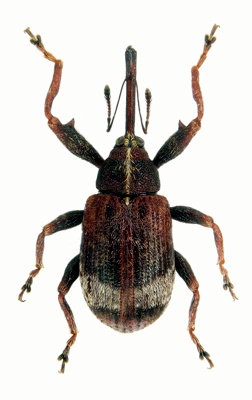Pests
Anthonomus pyri Boheman - Pear bud weevil
Systematic position.
Class Insecta, order Coleoptera, family Curculionidae, genus Anthonomus Germar.Synonyms.
Anthonomus piri Kollar, A. cinctus Redtenbacher.Biological group.
Pest of pear.Morphology and biology.
Body length without rostrum 2.8-4.5 mm. Adults are brownish. Rostrum long and slender, almost parallel-sided, slightly thickened in apical part and weakly dorso-ventrally curved. Pronotum with longitudinal median narrow band, consisting of light hairs. Hind third of elytra with bright and light transversal hairy band. Basal part of 3rd interstria distinctly convex and widened, covered with velvety pubescence consisting of brown and black hairs. Femoral tooth is simple, with one apex. Tarsal claw with additional denticle. Egg white, ovate, 0.7-0.8 mm in length and 0.6 mm in width. Larva white, with brownish head; body length of mature larva, 5-6 mm. Pupa is yellowish-white.Distribution.
Middle and Southern Europe, Northern Africa, Asia Minor. The species inhabits the European part of the former USSR, including Trans-Carpathia, Moldova, Crimea and probably whole Caucasus. A record of A. piri in Western Siberia (Prokof.ev, 1987) is doubtful.Ecology.
Monovoltine. Pear and in lesser degree apple are the main host plants. The species usually hibernates in the larval stage inside generative buds, but in the northern part of the area, it sometimes hibernates in the stage of egg. In spring, larva devours the interior part of bud. Pupation occurs during April-May inside the bud. Adult of new generation gnaws a round hole in bud scale and usually appears after pear blossoming. Summery diapause of adults lasts to autumn under the bark and in the litter. In September, adults appear in orchards again and copulate. Female lays eggs inside generative buds mainly. Fertility is about 10-25 eggs. Hatching of the first larvae occurs in October.Economic significance.
The beetle damages in larval stage mainly. In Europe, it is known as a serious pest of pear. In the former USSR, the Pear Bud Weevil sometimes damages in Transcaucasia. In spring, strongly injured pear tree looks like frostbitten one. Control measures include insecticide treatment in the period from the end of harvesting to the beginning of the pest oviposition.Reference citations:
Avet'yan A.S. 1952. Pests of fruit plants in Armenian SSR. Erevan: AN Arm.SSR. 183 p. (in Russian).Kryzhanovskii O.L., ed. 1974. Pest insects and mites of agricultural plants, V. 2. Leningrad: Nauka. 335 p. (in Russian).
Poiras A.A. 1998. Catalogue of the weevils (Coleoptera, Curculionoidea) and their host plants in the Republic of Moldova. Pensoft Series Faunistica N 10. Sofia & Moscow: Pensoft, 156 p.
Prokof.ev M.A. 1987. Siberian orchards protection against pests. Moscow: Rossel.khozizdat, 239 p. (in Russian).
Ter-Minassyan M.E. 1936. Review of weevils from Anthonomus Germ. and Furcipus Desbr. genera (Coleoptera, Curculionidae) of the fauna of the USSR. In: Kuznetsov N.Ya., ed. Proceedings of Zoological Institute AS USSR. V. 3: Moscow-Leningrad: AS USSR, p. 165-182 (in Russian).
Vasil.ev V.P. & Livshits I.Z., 1958. Pests of fruit crops. Moscow: Sel.khozlit. 392 p. (in Russian).


